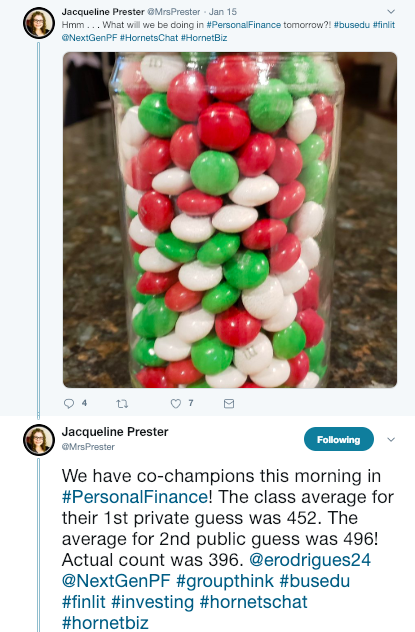Investing Activity Idea: How Can a Jar of Jelly Beans Teach Students About the Stock Market?
How can we teach students about the stock market when they have no investing experience?
I listened to this Masters of Business podcast with Barry Ritholtz interviewing investor and author Joel Greenblatt and picked up a few good ideas. Joel is not only a practitioner (a very successful hedge fund manager) but also an educator having spent the last 20+ years as a professor at Columbia Business School. Joel described the challenges of describing the stock market to a group of 9th graders at a Harlem high school and the ingenious idea he came up (about 48:20-51:00 in podcast):
- He brought in a large glass jar full of jelly beans.
- He passed the jar around the class and let each student write down their guess of the number of jelly beans on an index card. They developed these guesses independently.
- He collected the 3X5 cards from the class.
- He then asked students individually to provide their guesses publicly. They could keep their original guess (from the index card) or change it based on what they heard from other students. He jotted down their responses on the board and tabulated the results.
Here were the results from his experiment:
- Average from index cards: 1771
- Average from public guesses: 850
Actual number in the jar: 1776.
What happened?
- Students were cold and calculating in analyzing the jelly bean jar for their first "index card" guess.
- Students were influenced by social factors when making their public guesses. A great example of behavioral finance in action.
How does this relate to investing:
- Lots of investing "noise" out there (news, blogs, CNBC, friends with stock tips) which can influence you in ways that make you a worse investor. Be cold and disciplined with your investing approach and learn to shut out the noise.
I can't wait to try this with my class later this summer. Stay tuned for an update to this post.
---------------------
Update (7/13/18): Each of my three sections had similar results in that the index card average (aka "private estimates") came very close to the actual answer. When they had an opportunity to discuss with others and change their answer and had to state it publicly ("the public answer"), the average dropped dramatically and moved further away from the average.
Here were the most dramatic results from section 2:
Three other teacher tips for this activity:
- I used three different jar sizes for each of the three sections. Yes, kids were excited to talk to their classmates about what they did in personal finance class. One student overthought it and figured that one jar was 1/3 the size of the others so came up with a guess that way.
- After students handed in their index cards, I gave them 2 minutest to get up and talk with classmates about their estimates. I didn't tell them they would have another chance to guess until AFTER they were done talking, I told them there would be a round 2 where I would post all of their answers on the whiteboard and we zipped around the room to get their figures. I had 4-5 different students calculate the averages of the numbers on the board (with calculators) as I went, so we could get an average quickly and accurately (I used the number that at least 3 of them came up with, assuming that one was correct.
- I used M&Ms. Students agreed that more liked M&Ms vs. jelly beans. You can obviously choose an item that you think your students would enjoy.
- To raise the stakes for the public answers, I would let them know that the M&Ms will be awarded based on who comes closest with these guesses.
-------------
Update: 1/18/19:
Here's what happened in Jackie Prester's classroom when she ran this activity: 
About the Author
Tim Ranzetta
Tim's saving habits started at seven when a neighbor with a broken hip gave him a dog walking job. Her recovery, which took almost a year, resulted in Tim getting to know the bank tellers quite well (and accumulating a savings account balance of over $300!). His recent entrepreneurial adventures have included driving a shredding truck, analyzing executive compensation packages for Fortune 500 companies and helping families make better college financing decisions. After volunteering in 2010 to create and teach a personal finance program at Eastside College Prep in East Palo Alto, Tim saw firsthand the impact of an engaging and activity-based curriculum, which inspired him to start a new non-profit, Next Gen Personal Finance.
SEARCH FOR CONTENT
Subscribe to the blog
Get Question of the Day, FinCap Friday, and the latest updates from NGPF in your inbox by subscribing today:
MOST POPULAR POSTS

.JPG?1531490070597)






